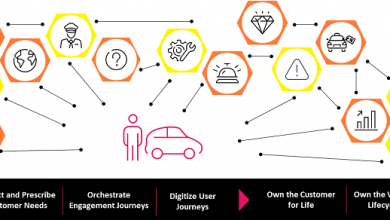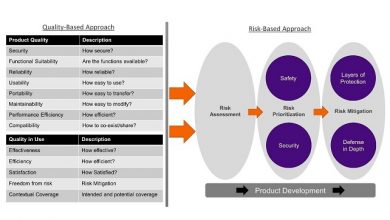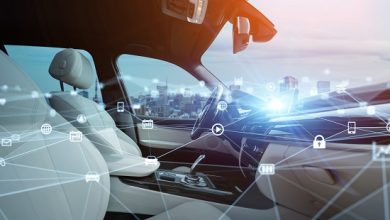Data and Information Management – Challenges and Opportunities for Automotive Manufacturers

The automotive industry is undergoing a profound change with the aim to transform the driving experience, fuelled by innovative technologies like IoT and 5G. With the focus on efficiency and business growth, automotive manufacturers are adopting Industry 4.0 techniques in design, manufacturing, and supply chain management. A general shift away from the internal combustion engine (ICE), towards increasing focus on alternative forms of transmission, such as Electric, Hybrid and Hydrogen fuel cells is also being seen.
Manufacturers are keen to unlock the value of vehicle to everything (V2X) connectivity, with ADAS (Advanced driver-assistance systems) technology providing a stepping-stone towards fully autonomous vehicles, as well as addressing current applications including automated toll road payments, predictive maintenance, enhanced roadside assistance and emergency response mechanisms. Changes in regulations governing safety, emissions, and emergency response mechanisms and new approaches to vehicle ownership and access are further enabling this sector to embark on the transformation journey of the complete ecosystem.
FROM CONNECTIVITY TO INFORMATION MANAGEMENT
Analytics plays a central role in achieving this transformation of the automotive sector. So how do manufacturers make the most of data? Today’s vehicles are data centres on wheels. They can have 100s of built-in sensors, and thousands of lines of software code permanently monitoring multiple factors, such as speed, engine temperature, braking, proximity and many other functions.
The connected vehicle is collecting data from multiple sources- either for use across the vehicle itself, or for external transmission. Modern vehicles generate around 25 gigabytes of data every hour. Autonomous cars will generate even more data, up to 3,600 gigabytes of data per hour, according to expert forecasts.[1]
Accompanying this shifting focus, the value in the vehicle changes from the hardware aspects of the car such as steel, rubber, plastic, and copper wire towards value of the software and content associated with it. Within a decade the value paradigm would have shifted towards a data and content data paradigm.
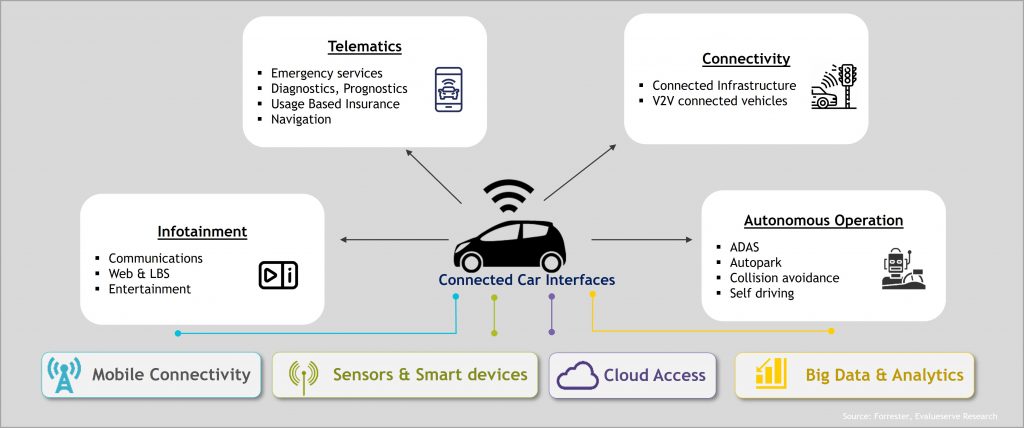
Demand for built-in connectivity and telematics in automobiles has resulted in technological improvements, which aim at enhancing the overall in-vehicle experience for the passengers as well as drivers. With the connected vehicle, widespread embedded cellular connections are enabling new ways to inform and entertain drivers, as well as maintain the vehicles over its lifecycle. As vehicle functions become ever more defined by software, the ability to update software OTA (over the air) makes embedded cellular connectivity an essential means of maintaining the security and relevance of cars over the vehicle lifecycle. The next five years will see connectivity transition from being a support for improved user experience to providing core, mission-critical functions for personal mobility.
The data derived from connected vehicles can be used across the entire value chain, from vehicle development and production, through the Dealer/Reseller network, to sales and after-sales service. Data can also be used to monetise services post-sale. For example, with a more software defined vehicle, it is possible to ‘unlock’ new features and services post-sale using SOTA techniques. In support of this idea, according to industry consultancy company McKinsey report, on a per vehicle basis, connectivity could deliver up to $310 in revenue and $180 in cost saving per year on average by 2030[2]. That’s a big opportunity in a relatively stagnant market when measured on volume.
While there are opportunities associated with vehicle data, there are several challenges associated with getting access to accurate data. These challenges include:
• Visibility and Transparency – Is it possible to get access to the same data that the Mobile Network Operator has?
• Control – Who owns the data? What are the local regulations around data privacy, data sovereignty?
• Security – How to ensure secure data transmission between the vehicle, the mobile network, and the OEM data centre?
• Excessive Data Collection – Too much data can lead to consumption of unnecessary resources and not being able to monetise well. You need to know how to use the data, not just collect it!
As much as data that can be derived from a connected vehicle, there is the issue of the medium through which it is collected, which in most cases is the terrestrial cellular network. The cellular connection not only transports information from the vehicle, but adds additional information, including factors such as location, quality of connection, usage, identity. This combination of vehicle and communications medium represents an interesting opportunity to enrich the services and capabilities associated with connected vehicles.
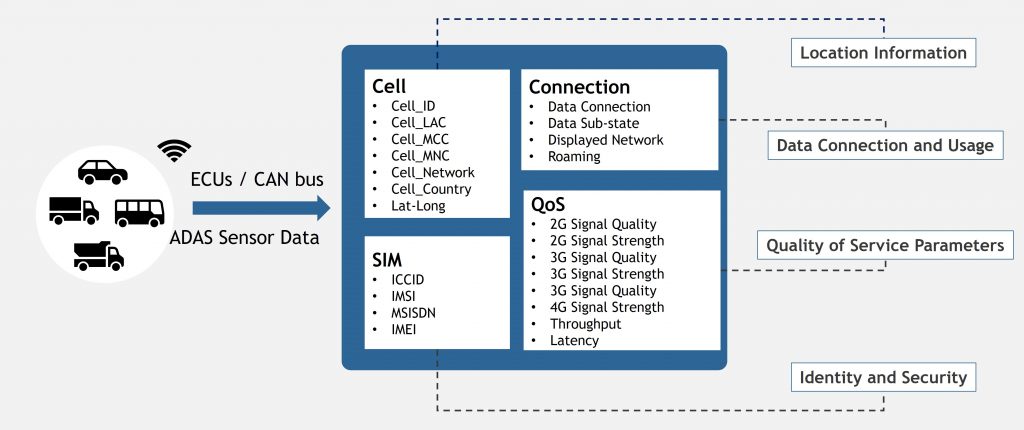
If we consider all the data that will be generated with vehicle-to-everything (V2X), the combination of vehicle data and the medium used for connectivity is critical. Many V2X use cases can be realised with the advent of 5G technology. At this stage we can introduce Mobile Edge Computing (MEC). With a combination of 5G and Mobile Edge Computing more data can be processed, faster. Operational data and post event analytics become more complex, with the blurring of network functions and data processing functions.
It should also be noted that not all data is equal. Some data needs low latency, real-time transmission, and processing. Other data can tolerate higher latency. It is important to understand how to prioritise what data needs to be processed and in what way. Let us consider a safety scenario, such as collision avoidance, which needs real time analysis and a quick reaction time, usually in tenths of a milli second. Such a service requires low latency and high data payloads while lower latency, lower data payloads such as predictive maintenance, traffic updates, route mapping can be managed using higher latency, slightly lower priority processing.
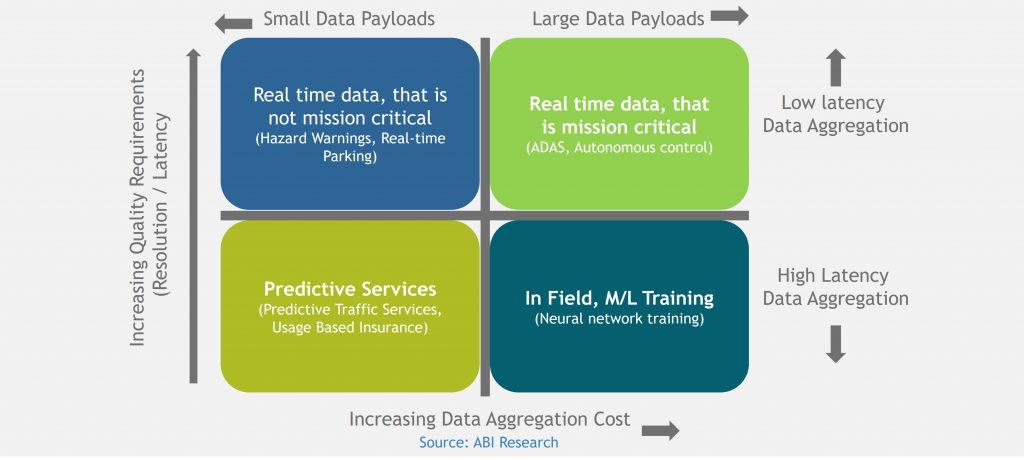
While mobile edge computing can help manage this, there are different definitions of what and where the edge resides. The reality is that there can be multiple ‘edges’ at any one time. Questions such as how to access edge computing assets, how to determine when and where to process data in the mobile network edge and when to send and process data to the cloud need to be responded in near real-time for data management to run efficiently. Remember some data may need to be processed in the mobile network edge and sent for storage and retrieval in the cloud.
Data needs to be transformed into information, along multiple dimensions to provide efficiency and deliver an enhanced driver experience:
- Commercial use – to monetise the data such as customised infotainment packages, usage-based insurance among others
- Operational use – to provide optimum efficiency such as predictive maintenance, tracking, monitoring, theft alerts etc.
- Post event processing for analysis and use in vehicle development and for other critical purposes, such as accident information to make the car safer
If we just focus on one aspect of data management – enhancing the driver experience – it is possible to identify a range of value-added services: V-Commerce and payment services; Congestion charging; Usage Based Insurance; Automated toll road & vehicle tax payments; Entertainment and Infotainment services; Automated parking charges.
As the phenomenon of the connected vehicle develops more broadly, automotive OEMs need to evolve the connectivity management platform into a broader data management and monetisation platform. This would need information about the communications layer and management of the communication interfaces . For this to be efficient it needs to be done not on a country-by-country basis, but preferably on a global basis. With a single point of contact to manage connected vehicle fleets in multiple countries and territories.
The connectivity management platform must evolve to become both a technology enabler as well as a commercial enabler. This broader approach enables automotive OEMs to realise the full potential and commercial value of the data that connected vehicles are generating.
[1] Source: T-Systems
[2] https://www.mckinsey.com/industries/automotive-and-assembly/our-insights/unlocking-the-full-life-cycle-value-from-connected-car-data
Author:

Avneesh Prakash
Vice President – Mobility
Tata Communications
Avneesh has 27 years of rich experience in technology and digital businesses. He has established and scaled digital businesses around areas such as digital identity & biometrics, India’s Aadhaar programme, financial inclusion and digital field services, leading the development of digital SaaS platforms in the process.
Published in Telematics Wire


